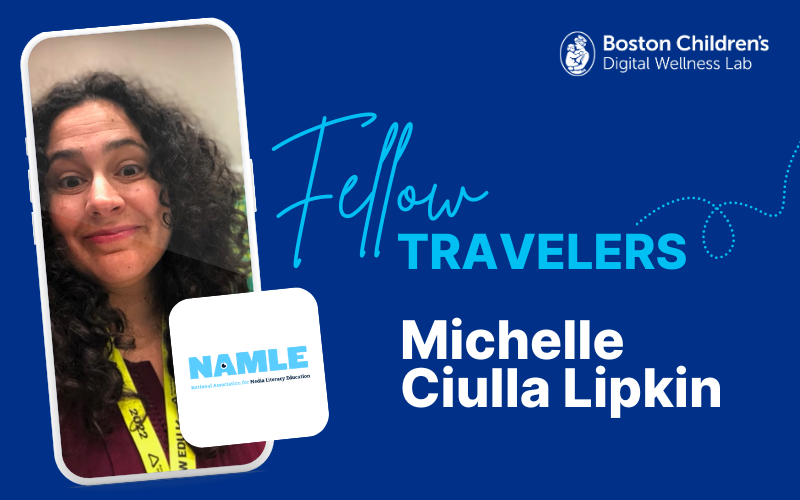Michelle Ciulla Lipkin
Executive Director, National Association for Media Literacy Education (NAMLE)
What is NAMLE’s mission?
NAMLE’s vision is to see media literacy education highly valued and widely practiced as an essential life skill. As the umbrella organization for U.S. media literacy education, NAMLE amplifies the work of our 8,500+ members and our 60+ organizational partners; acting as a resource, a convener, and a leading voice.
We organize annual national conferences, host U.S. Media Literacy Week (now in its 10th year), and coordinate the National Media Literacy Alliance of teacher membership organizations.
The NAMLE community is large and there is incredible work being done around the country. Our membership is a diverse group that comes to media literacy education in many different ways. We have educators, researchers, librarians, community based organizations, students, educational leaders, advocates, public media, and industry leaders.
It’s a vast network that represents all the varied ways to get to media literacy education in formal and informal settings.
What led you to this work?
My path to media literacy has been both professional and personal. Professionally, I started my career in children’s television. Working in production at Nickelodeon, I learned so much about the television industry, and the corporate push for marketing and promotion. This led me to be interested in how consumer culture has impacted the kids watching the shows I was working on. I decided to go to graduate school to understand more about media impact. Through my studies, I discovered the media literacy community.
On a much more personal level, I discovered at an early age the impact media, specifically the news can have on an individual. In 1988, when I was 17, my father was killed in a plane crash that made international news which continues to this day. (This article from PBS.org explains more.) Once you become the subject of the news, you never fully can separate yourself from the impact media can have on people. I have such a personal connection to media literacy because of my family’s tragedy.
What have you learned in the course of doing this work about young people’s wellness while engaging with tech and interactive media?
I have learned the importance of empowering young people with the tools they need to be successful in this technology-driven world. We need to give young people agency, listen to them, and learn from their experiences. Digital wellness cannot be accomplished if we solely focus on protecting young people. We need to educate, engage, and empower them. I believe that the key to digital wellness is media literacy education because it allows young people to build skills and a knowledge base that will help them throughout their life.
You can read my recent response to Jonathan Haidt’s The Anxious Generation here. This captures my feelings on the growing protective cultural narrative which I believe is incredibly unhelpful to young people.
What guidance or advice do you have for parents and other caregivers to help kids to build and maintain their wellness when engaging with digital media and technology?
Our advice for parents can be summed up in this resource series that we created as part of our partnership with Roblox entitled “The 6 E’s of Parenting in the Digital Age”
To summarize, the 6 E’s are: exemplify, explain, engage, educate, empower and empathize. The common element to all of these is communication and openness. We must communicate clearly with young people and not at them. We must actively listen to them and allow them to have a voice. We must recognize our role as adults is to give young people the opportunities to build the skill set to be independent, productive, and engaged participants in society. We can only do this if we educate and prepare them for the world. Parents should be advocating for media literacy education in their children’s schools and their communities.
How would you change or design technology and/or media to be healthier for kids across the developmental span?
I’ve been paying a lot of attention to these efforts at the Joan Ganz Cooney Center at the Sesame Workshop, which I think are very important. I agree that thinking about digital wellbeing during the design phase of technology is key to building tools that work for us and not against us. We also need to consider the age of the user and build ways to ensure the youngest users are shielded from harm. We also need to build media literacy interventions into technology so that user experience includes moments to hone our media literacy skills.
Is there anything else you’d like to share?
I’d like to reiterate that our efforts to build a more empowering, inclusive, and civil online world depend on our ability to move beyond a protection framework towards one that teaches the important skills needed to thrive in this complicated world. And I believe the digital wellness movement deserves a lot of attention, which is why NAMLE is proud to be an Advisor for the Inspired Internet Pledge.
More resources from NAMLE:
- #medialiteracy
- @medialiteracyed
- https://namle.org/
- https://namle.org/6-es-of-parenting-in-the-digital-age/
- https://namle.org/a-parents-guide-to-media-literacy/
We know that no one person, organization, or company can successfully address the challenge alone, so it’s imperative that we collaborate to design and maintain a healthier digital experience for all young people and their families. Our Fellow Travelers blog series features colleagues from around the world who focus on digital wellness from a different perspective than the Digital Wellness Lab, enabling us to share expertise in key areas of digital wellness that we don’t explore as deeply.
Here at the Lab, we welcome different viewpoints and perspectives. However, the opinions and ideas expressed here do not necessarily represent the views, research, or recommendations of the Digital Wellness Lab, Boston Children’s Hospital, or affiliates.








